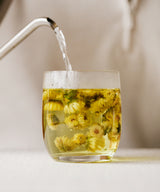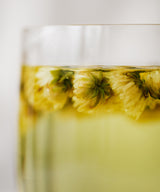Silk Chrysanthemum Bud
有机杭白胎菊
Harvest
November 2023
Origin
Tongxiang, Zhejiang
Our Silk Chrysanthemum Bud Tea is made of Hangbai Chrysanthemum, one of the four famous chrysanthemum varietals native to China. Hangbai Chrysanthemum originates from Tongxiang County of Zhejiang Province, where it has been cultivated for more than 380 years. These small, yellow flowers are regarded as one of Zhejiang Province’s 'Intangible Cultural Heritage' items.
Hangbai Chrysanthemum is revered for the intensity of its golden colour and the concentration of its medicinal properties. Even in the dried buds one can see the striking yellow center, contained by the thin, curled petals and the silver-green flower cap that once attached to its stamen. This tea appears very dense with pigment, scent, and also potential.
As highly regarded as chrysanthemums are, they are hardly grown in this region anymore. The chrysanthemum is an annual plant, which means it requires transplanting and propagation by stem cutting each year. On top of that, the traditional method of processing the flowers involves complicated techniques that require a great deal of time. Since cultivating them is so labour intensive, the cost of carrying it on is too high for most families when compared to the opportunities for higher wages earned in the area's dominant textile industry. As a result, the chrysanthemum-making traditions that had lasted for over 300 years have quietly disappeared.
Our Silk Chrysthemum is made by a couple, Mei and Yu, who are consciously resisting this trend. They returned to their hometown, Tongxiang, in their late 30’s where their family was operating a silkworm farm and making silk bedding. Mei and Yu had a keen interest in the revitalization of traditional craftsmanship and cultural heritage, which motivated them to convert a small plot of land (a quarter of an acre) on their family property to a biodynamic farm for the purpose of cultivating and processing Hangbai Chrysanthemum using traditional methods. They named their chrysanthemum “Silk Chrysanthemum,” as it was understood to be as valuable as the silk their family had crafted for generations.
This small venture was by no means an easy one. First off, they discovered that no one in the village had any seeds of the local heirloom varietal of chrysanthemum. In fact, Hangbai Chrysanthemum had gradually disappeared more than 10 years ago. In 2018, through pure chance, they discovered that a childhood friend had been growing a few of the native varietals in their family garden. They were able to start their farm with these last remaining local flowers.
Mei and Yu carry fond memories of walking around the chrysanthemum fields as children, watching their mother and grandmother moving around the chrysanthemum plants like bees, collecting their yellow buds. At night time their kitchen would fill with hot steam and the refreshing fragrance of the flowers as many trays of them were processed for drying. The quality of these memories encouraged them to endure the challenging times that came with cultivating the flowers themselves: when the yield is impossibly small, when the flowers freeze, when they are eaten by chickens, or when they wane because they choose not to use fertilizers. This is their 5th year operating their tiny organic chrysanthemum farm in their hometown. It is currently the only chrysanthemum farm in the region.
At Mei and Yu’s each chrysanthemum bud is harvested carefully by hand in the morning. At night, they are processed using a centuries-old steaming method: wood from local camphor trees is used to start a fire, small batches of 250 grams of fresh chrysanthemum buds are placed inside handwoven bamboo baskets and are steamed for 4 to 5 minutes over the fire. The buds are then baked for 4 to 6 hours, and then sun-dried for 2 to 3 days on the bamboo baskets. A final round of baking over camphor charcoal dries the buds thoroughly. When prepared this way, this tea will last a long time and be able to travel great distances without the addition of sulfur.
This year’s harvest brews a strong, vibrant liquor. Its medicinal qualities are less forward than previous years, allowing its dusty sweetness and beautiful, floral aspects to appear more prominently. This is a balanced, complex and high-potency example of one of the four classic varietals of Chinese chrysanthemum.
. . .
Brewing guide
| Tea | 2.5 g |
| Temperature |
100 °C |
| Water | 200 ml |
| Steep time | 1 min, 2 min, 3 min+ |
| No. of infusions | 6 |












